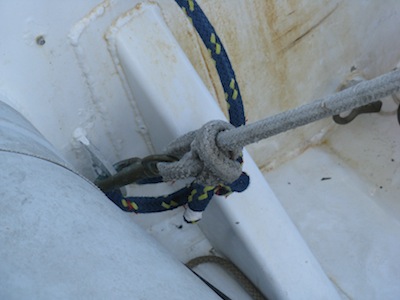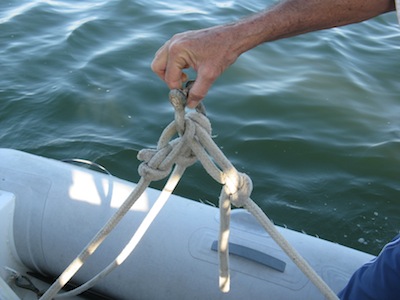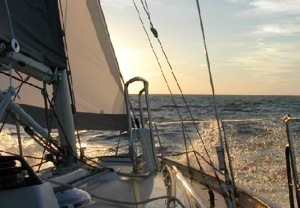If you’re headed for cruising outside US waters, you’ll need a way to keep your dinghy and outboard safe from theft.
Davits are nice, davits with metal cables instead of line pulleys are even more secure. And be sure to lock your dinghy to the boat even if you have davits.
When we were actually out of the US cruising, we removed the outboard from the dinghy and always locked it on the boat rail in the cockpit each night.
Opportunity thieves are rarely interested in an inflatable dinghy. But they’ll steal the dinghy to get the outboard. Then simply slash the inflatable tubes and sink the dinghy.

In almost every country we’ve visited it’s always possible to buy another outboard — all the fishermen use them. But virtually impossible to buy a dinghy. So by separating them, we made it harder (i.e. less “opportunity”) to steal our outboard right off the boat rail in the cockpit. It added maybe 10 minutes to our daily routine — time well invested to keep our daily transportation, i.e. “family car”.
We don’t have davits because we opted for a Monitor Windvane as part of our self-steering strategy instead of davits when we outfitted Winterlude for cruising.
But leaving the dinghy trailing the boat in the water can be inviting opportunity theft. If your dinghy is the easiest to take in any anchorage, you may be the next victim. Make it more difficult by hanging your dinghy. But keep in mind, opportunity thieves are getting more aggressive as cruisers are making it harder to take their dinghies. When we were last in Belize, they would drift up under the dinghy in an outboard launch, cut the bridle lines, dropping the entire dinghy into their larger boat and the first indication cruisers had that anything was amiss was the roar of a large outboard when the launch sped away.
We do it from the hip of our boat via a spare halyard, a bridle David made from line and a block and tackle. It’s easier if you have a winch on your mast, but we don’t.
We always lock the dinghy to the side of the boat. It’s possible to cut our bridle, but if the thieves are observant, they’ll notice the oversize cable and lock and know they’ll have to cut it before they can drop the dinghy. The cable is locked right outside our pullman berth portholes, so hopefully we’d hear them and have a chance to chase them away. It never happened.
Here are the photos of our bridle as a starting point if you want to make your own:






Obviously, it’s easy to tie the bowlines in different places to rebalance when the outboard is not on the dinghy for hanging.
This is just our solution. I’m sure others have better solutions. Please share and let us know by leaving a comment! That way when it’s time to replace ours, maybe we’ll use someone else’s better ideas! 🙂 Cheers — Jan














Hi Jan,
I had to search this post after we recently bought a dinghy and took it to our boat. Ours is a RIB from West Marine and it’s 10.5 feet long. We get the part about how you secure it to the hip overnight, but how in the heck do you get it back on deck when it’s time to go? We wrestled with that beast for two hours before we gave up, hauled it up onto the dock (we were still in our slip), took down the lifelines on that side and one of us pushed from the dock and the other pulled from the deck. Clearly, that will not work when we’re on a mooring or anchored. We also tried swinging the boom out as a crane, also our staysail boom but neither gives us the right angle to quite get it up and over the gunwhales. How do you do it?
Thanks,
Judy
Hi Judy! Oops, I guess we’ve done it so long that I forgot that part! We use our extra jib halyard/spinnaker line. Hook it to the bow eye on the dinghy. Some people crank it from the mast because they have a winch there, but we don’t so we lead it back to the primary jib winch in the cockpit and I crank 44 times up to lift it vertically, straight in the air, until the stern is over the lifelines. Then David grabs it & positions it on the foredeck and I lower the extra jib halyard to lower the dinghy to the deck. Maybe 10 minutes tops. David just said, maybe we should do some photos to show how we do it. It’s nothing fancy, that’s for sure, but I’m bummed that you had to struggle to get it onto the dock & onto the boat when maybe there’s an easier way. So so sorry! We’re in the middle of finishing varnish right now, but I’ll try and get a Step By Step post done in the next few days to illustrate. It might not work exactly the same on your boat, but I’m sure it would give you some ideas on how to rig it for you. Thanks for asking! Cheers! Jan
[…] you hang your dinghy either from davits or “on the hip” with a halyard, don’t forget to remove the drain plug if there’s a chance of monsoon […]